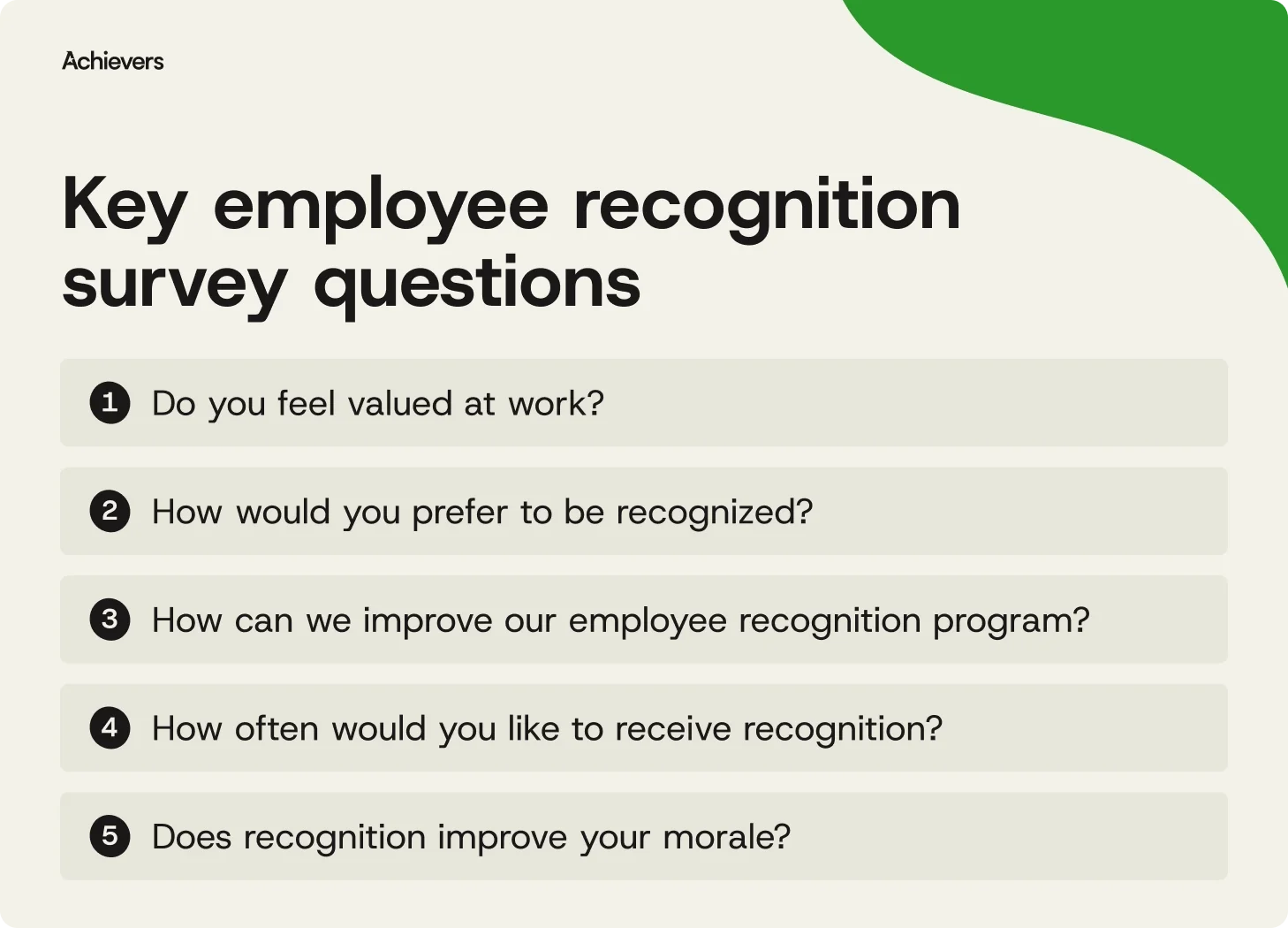Table of contents
Create a culture that means business™
Schedule a demo with an Achievers solution expert today.
If you’re running a recognition program, the right employee recognition survey questions aren’t optional — they’re essential.
Plenty of companies invest in recognition — only to wonder why it isn’t landing. Often, the answer’s simple: recognition programs only work when they reflect what employees actually want. And spoiler: those wants change.
A good survey shows you what’s working, what’s missing, and how to make recognition stick. When it’s personal, meaningful, and shaped by feedback, recognition moves from a nice moment to a powerful driver of productivity, engagement, and retention. Achievers’ 2025 State of Employee Recognition Report found that employees recognized weekly are 2x more productive and 9x more likely to feel like they belong.
Ready to find out what really makes recognition work? Let’s go.
25 employee recognition survey questions
Recognition works, but only when it’s built around what employees actually want. A recent study by Canva found that 94% of employees who feel highly appreciated say they love their workplace. That’s the kind of impact recognition can have when it’s done right.
Use these employee recognition survey questions to uncover what’s working, what’s not, and how to make recognition more meaningful, motivating, and worth the effort:

1. Are you satisfied with the amount of recognition you receive at work?
If people aren’t feeling seen, they’re not going to feel especially motivated. This one’s your baseline — a quick check on whether recognition is happening often enough to make a dent. Look for trends across teams to spot where the gaps are hiding (or who needs a gentle nudge).
2. What benefits do you most value, and what new incentives would you like to see offered?
Perks are great — until they gather dust. Ask this to get a sense of what actually matters to your employees right now. Needs shift. Life happens. And the gym subsidy might not beat out childcare support or a few extra mental health days.
3. Do you feel valued at work?
If this one misses the mark, it’s time for some honest reflection. Employees who don’t feel valued won’t be motivated to give their best — or give notice when they leave. Quick pulse surveys, polls, or even a single-question quiz can make it easy for employees to respond without overthinking. Just make sure to leave space for comments. (Hint: The gold’s usually in the nuance.)
4. Do you understand what types of behavior are recognized here?
“Great job!” is nice. But if employees aren’t clear on what exactly earned the praise, it’s not recognition; it’s a missed opportunity. Use this question to see if your people know what great looks like, and whether you’re actually reinforcing the behaviors that move the business forward.
5. How would you prefer to be recognized?
Not everyone’s angling for the branded mug. Some want public praise. Others want points-based rewards they can redeem for something meaningful, or a simple “thank you” that doesn’t feel phoned in. This question helps tailor your program to what actually resonates.
6. Are employees recognized fairly across the organization?
Recognition loses its impact when it feels like a popularity contest. Use this question to check whether everyone — across roles, teams, locations — has an equal shot at being recognized. If they don’t, the ripple effects go far beyond your program.
7. Are you recognized appropriately for reaching important milestones?
Milestones matter. Whether it’s sending a work anniversary message, celebrating a big win, or finishing that certification that took three months and all your free time, these moments deserve more than a passing “nice work.” This question helps you spot whether those efforts are being properly acknowledged (or quietly ignored).
8. How can we improve our employee recognition program?
Simple, direct, and often revealing. Employees know what’s working and what’s not — you just have to ask. The answers might be small tweaks or big ideas. Either way, you’ll come away with insights you wouldn’t get from another vendor pitch.
9. What would make recognizing others easier?
Let’s face it — even the most well-meaning employees won’t jump through hoops to send a thank-you. Use this question to identify pain points and speed bumps in the process. If it’s not easy, it’s not happening.
10. How frequently do you give recognition?
This one pulls back the curtain on daily habits. If the answer leans more toward “rarely,” it might be a sign that your program isn’t top of mind or isn’t meeting people where they work. Consistency is key, and this question tells you if recognition is actually part of the culture or just another item on the to-do list.
11. How frequently do you receive recognition?
This flips the spotlight. It’s one thing to give recognition, but are employees actually on the receiving end? Use this question to see if your culture is as reciprocal as you think. Bonus: multiple-choice timeframes (“daily,” “weekly,” etc.) keep responses clean and the insights clear.
12. Do you receive enough recognition from your manager and other leaders?
Recognition hits different when it comes from the top. If employees aren’t hearing it from their managers or leadership, you’ve got a visibility problem — and possibly a retention one. The fix? Make sure leaders understand their role in modeling a culture of recognition (and no, an annual all-hands shoutout doesn’t count).
13. Is it easy to engage with others’ recognitions using our employee recognition platform?
If your platform feels like a trip back to 2004, people won’t use it — no matter how well-meaning the program. This question helps you surface whether the tool is intuitive, embedded in daily workflows, and — dare we say — fun to use.
14. Can you provide recognition when and where you want to?
Recognition shouldn’t be desk-dependent. In a hybrid world, your people need tools that work wherever they are — in the office, on the floor, or on the go. This question helps you check whether your tech is keeping up with your workforce (and not the other way around).
15. How often would you like to receive recognition?
Frequency matters — but so does preference. Some employees thrive on daily feedback, while others prefer a more occasional pat on the back. Knowing how often they want recognition helps you build a program that hits the mark.
16. Do you receive meaningful recognition?
Not all recognition is created equal. A generic “nice job” doesn’t exactly move the needle. This helps you find out if recognition is doing what it should: feeling personal, timely, and genuinely meaningful. Because if it’s not meaningful, it’s just noise.
17. What type of rewards would motivate you the most?
You can’t reward everyone the same way and expect universal impact. This question cuts through the guesswork and helps you tailor your rewards catalog to what people actually care about — whether that’s big-ticket items, everyday wins, or the chance to give back. (Spoiler: it’s usually all three.)
18. How can HR make the recognition program better?
Let’s skip the suggestion box and go straight to the source. When employees can share ideas for improvement — especially anonymously — you get sharper feedback for your managers, stronger buy-in, and sometimes the kind of insight that makes you wonder why you didn’t think of it sooner.
19. Is the recognition program accessible to use?
Even the most well-designed programs won’t fly if employees can’t figure out how to use it. This question uncovers usability blind spots. Think confusing logins, clunky interfaces, or platforms that feel more “corporate compliance” than “culture driver.” Recognition should feel seamless, not like a scavenger hunt.
20. Can you recall a recent example of impactful recognition?
When employees go the extra mile and get a pat on the back (or worse, nothing at all), it sends the wrong message. This question reveals whether high effort is being met with high-impact recognition — the kind that reinforces and retains your top talent.
21. Is recognition easy across locations and countries?
Global teams shouldn’t mean global inconsistency. If recognition feels effortless at HQ but impossible in remote offices, your program’s siloed, not scaled. This question helps reveal whether your tools and processes a diverse workforce.
22. When was the last time you received recognition from management?
If more people are squinting at this one, trying to remember, then that’s a problem. Recognition from leadership doesn’t have to happen daily, but it should happen regularly — and recent enough not to require a calendar search. Use this question to find out where the disconnects are happening.
23. Does recognition improve your morale?
Time to draw a line between recognition and culture. Does appreciation life your team up or fall flat? If recognition isn’t boosting employee morale, the issue might be frequency, delivery, or relevance — and this question helps you start narrowing it down.
24. Does the organization value and recognize innovation?
Innovation doesn’t happen in a vacuum. It needs encouragement, visibility, and yes, recognition. This question helps you find out whether employees feel their ideas are welcomed and rewarded or left on the shelf until someone else says them louder.
25. Does the company culture promote employee engagement?
It’s the big-picture question, but a crucial one. Recognition isn’t a side dish; it’s the main ingredient in shaping an engaged, motivated workforce. This question connects the dots between your recognition efforts and the company culture you’re trying to build. If it’s not resonating, now’s your chance to steer the ship in a new direction.
How to create an employee recognition survey
The secret to a great recognition survey? Ask the right questions — in the right way, at the right time.
Want better recognition outcomes? Start by asking better questions — the kind that get real answers, spark meaningful change, and don’t put employees to sleep.
Here’s how to do it right:
Step 1: Know what you’re measuring
Begin with a goal. Are you looking to gauge recognition frequency? Understand preferred recognition styles? Measure fairness and impact? Get specific. Clear objectives lead to better questions — and better data.
Step 2: Build questions that make sense
Avoid jargon and keep things short. Use a mix of scaled questions (“On a scale of 1 to 10, how recognized do you feel at work?”), multiple choice, and open-ended prompts. Bonus points for making it mobile-friendly and anonymous — no one wants to stress over survey drama.
Step 3: Time it well
Recognition surveys don’t need to be annual productions. The benefit of pulse surveys, quarterly check-ins, and timing them after key events (like performance reviews or company milestones) is that they can give you fresher, more relevant insights. The goal is to catch people when the experience is still top of mind.
Step 4: Analyze with intent
Once responses are in, look for patterns. Are managers recognizing consistently? Do some teams feel overlooked? Is there a disconnect between what’s being rewarded and what’s actually motivating people? Let the data show you where there’s room to improve.
Step 5: Close the loop
The worst thing you can do after a recognition survey? Nothing. Let employees know you’ve read the feedback, what you’re doing about it, and when they’ll see those changes. A little transparent communication builds a lot of trust — and keeps the feedback flowing next time around.
From survey questions to real recognition
Asking employee recognition survey questions is a great start. But if the answers only make it as far as a spreadsheet or a slide deck, you’re missing the point.
Real change doesn’t come from collecting feedback. It comes from acting on it. That’s where most recognition programs fall short. At Achievers, we make it easier to close the loop. Our platform helps you take what your people are telling you and turn it into everyday behavior — consistent, meaningful, and backed by workforce data.
Because if your team’s giving you insight, the least you can do is do something with it.



